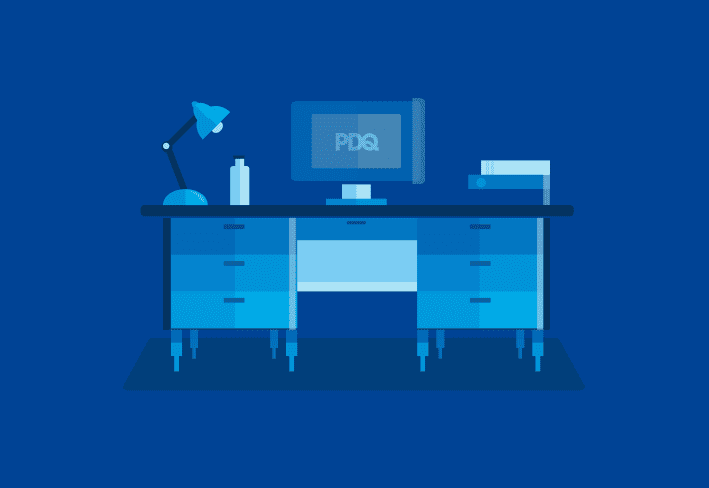A sysadmin (systems administrator) is responsible for maintaining an organization’s IT infrastructure — everything from hardware and software to updates and access control. In short, they keep systems running and secure so everyone else can work.
Or in other words, they’re kind of a big deal.
While sysadmins work largely behind the scenes, they’re invaluable for ensuring that a system runs effectively, both on a large and small scale. After all, every minute lost waiting for an update, repair, or reboot is time, money, and productivity wasted. This makes an efficient, problem-solving sysadmin worth their weight in gold.
What does a sysadmin do?
Sysadmins are part repair person, part developer, and part architect. To get a bit more granular, here’s what the average day can look like for a sysadmin:
Install and configure operating systems: Sysadmins can literally define how business is conducted through configuration management. They’re responsible for installing necessary applications across networks, making sure servers run smoothly, updating programs on time, and more.
Monitor systems and software: Keeping up with installations and updates is no small task. Sysadmins should be on top of what’s current, what needs updating, and how to do it without messing with productivity.
Provide access to systems and data: Sysadmins make sure that various users have access to the systems and data they need, safely and securely. This can include everything from SSO and password management to user permissions and admin work.
Secure data: Nowadays, there’s no such thing as being too secure. Whether it’s maintaining documentation, updating applications, or setting up a network, a sysadmin better know how to do it without accidentally giving network access to an army of Russian bots.
Script and program: Coding and programming are becoming increasingly important to the sysadmin role, allowing them to improve system reliability and identify and fix potential problems much quicker.
Assist users: Not only do sysadmins assist individual users with everyday troubleshooting (“Is the internet down again?”), but they should also be adept at reworking problems to reduce future system failures and get rid of potential bottlenecks.
What is the typical sysadmin career path?
Sysadmin roles are available wherever there’s an IT infrastructure to be found. However, sysadmin roles, responsibilities, and pay can vary widely from industry to industry — and even from organization to organization. Here’s a rundown of how different factors can affect your pay (according to Payscale), lifestyle, and role as you step into a sysadmin position.
What are common sysadmin job titles and salaries?
Entry level: These roles typically include systems analysts and IT support specialists. They focus on basic troubleshooting, installations, and assisting users while gaining foundational experience.
Typical salary range: Around $68,000 annually at the start of a career
Mid-level: Mid-level positions include IT managers and system administrators. These roles involve managing hardware and software infrastructure, overseeing updates, and supporting day-to-day operations.
Typical salary range: Around $83,000 annually, with potential to reach six figures depending on industry and experience
Senior level: High-level roles like chief information officer (CIO) or chief technology officer (CTO) often involve strategic decision-making, leadership, and less day-to-day tech work. This path suits sysadmins looking to transition into broader organizational impact.
Typical salary range: $99,000 to $240,000 annually
What education and certifications do sysadmins need?
With new technologies, best practices, and challenges arising daily, any career within systems administration requires continuous learning and development. While a Bachelor’s degree in computer science or information systems can be a great jumping off point, continuing education with hands-on experience, training, and certifications can be crucial to maintaining an expertise within the field. What’s more, additional certifications can easily translate to a higher salary and better marketability.
What certifications help sysadmins advance their careers?
CompTIA A+: Certifies basic skills across multiple devices, operating systems, and more.
CompTIA Network: Builds on foundational knowledge to develop skills in design, configuration, management, and troubleshooting.
Microsoft certifications: Microsoft offers hundreds of certifications based on product, skillset, roles, and levels of knowledge.
Where do sysadmins earn the most?
Not surprisingly, location can make a huge difference in the earning potential for a systems administrator. According to most estimates, areas with higher economic growth and larger concentrations of Fortune 500 companies see sysadmin salaries that are, on average, around 40% higher than other areas.
Areas with the highest average salaries include US Eastern and Western coastal states such as:
California
Washington
New York
Maryland
Virginia
Hawaii
Washington DC
The lowest annual salaries can be found in Midwestern and Southern states, where economic output tends to be limited to smaller companies with a local presence.
International opportunities
If you’re looking to work abroad, a few popular routes include:
US companies with overseas presence
US Foreign services
US Government and military contracting
Global companies (think oil, banks, tech)
Different job markets favor different levels of education and certification, so you may find yourself doing a bit of extra work to make yourself a competitive candidate in whatever market you choose to apply in. However, local benefits, work-life balance, and the thrill of living abroad can make the search and the extra training worth it.
What tools do sysadmins use?
A sysadmin is only as good as the tools in their tech stack. Here are a few of the applications every sysadmin should know to help with troubleshooting, testing, and optimizing their system.
Notepad++: A free source code editor that conveniently supports several languages
WireShark: Captures and stores local network traffic for analysis
RDCMan: A tool for organizing and controlling multiple remote desktop connections
FileXilla: Uploads, downloads, edits, and saves changes to files from a web hosting server
PuTTY: A software terminal emulator used to allow an SSH to access a remote computer
7Zip: An open-source file archiver used to compress and uncompress files
WizTree: A Windows high-speed disk space analyzer
PDQ Deploy & Inventory: Tools for automating patch management and collecting system configuration data across Windows environments
PDQ Connect: A cloud-based remote management solution that helps sysadmins deploy updates, install software, and monitor endpoints from anywhere
Is a sysadmin career worth it?
Being a sysadmin means juggling pressure, solving problems on the fly, and often fixing issues before anyone else even knows they exist. But it also means building the infrastructure your organization runs on and earning real respect for keeping it all running.
Want to see what the sysadmin life is really like? Join the PDQ Community, where IT pros swap tips, scripts, and war stories. Or hop into the PDQ Discord to meet others who know what it’s like to live on-call and love it.



